The CallHelper Application for Bitrix24
Quick Start
The CallHelper application for Bitrix24 is a comprehensive tool that allows the manager to create and modify sales scripts in a convenient visual editor, quickly train new employees, analyze results of calls, and find options for optimizing work of the company. Also, CallHelper allows employees to organize convenient work with sales scripts and CRM data during calls.
In this guide, you will learn how the CallHelper application can help your company improve customer experience, and you will be able to start working in the application right away. This guide is brief – it contains information for a quick start only.
1. Install CallHelper
To install the CallHelper application for Bitrix24, you can either open the link and click Install or find CallHelper in Bitrix24 Marketplace and install it.
After the application is installed, the Sales scripts section appears in the left menu. Welcome to CallHelper!
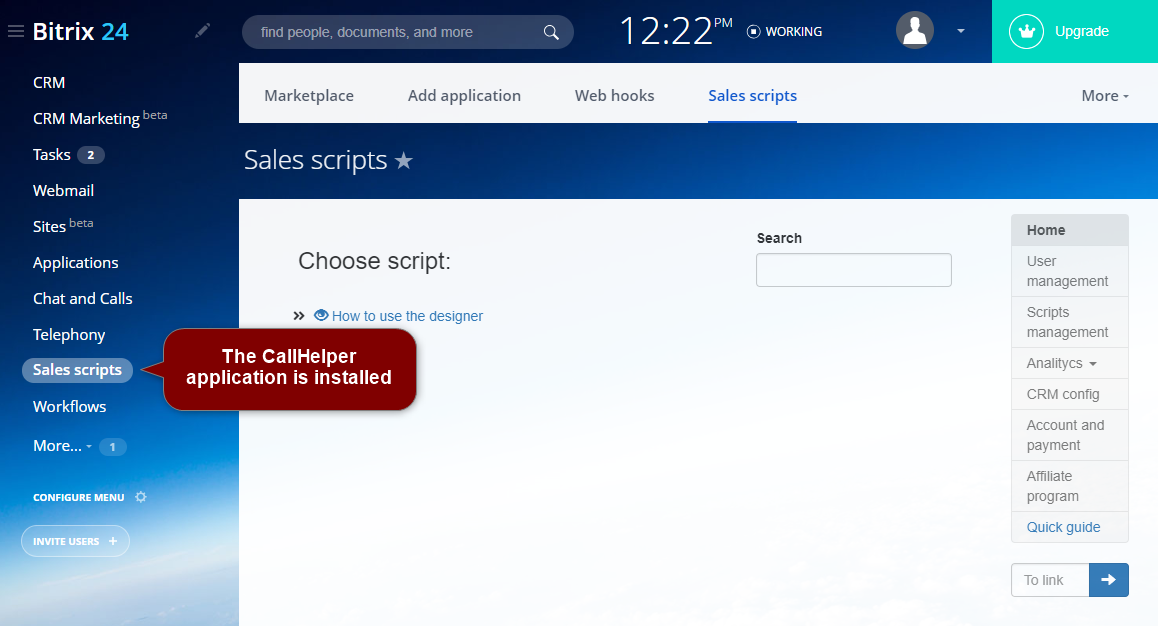
2. Configure User Rights
By default, a CallHelper administrator is an employee who was the first to open the application. In future, you can change the administrator or add new ones.
To set up access to CallHelper for other employees of the company, they need to open the application once under their account (the "not enough access rights" message will be displayed), after that the administrator will configure the rights.
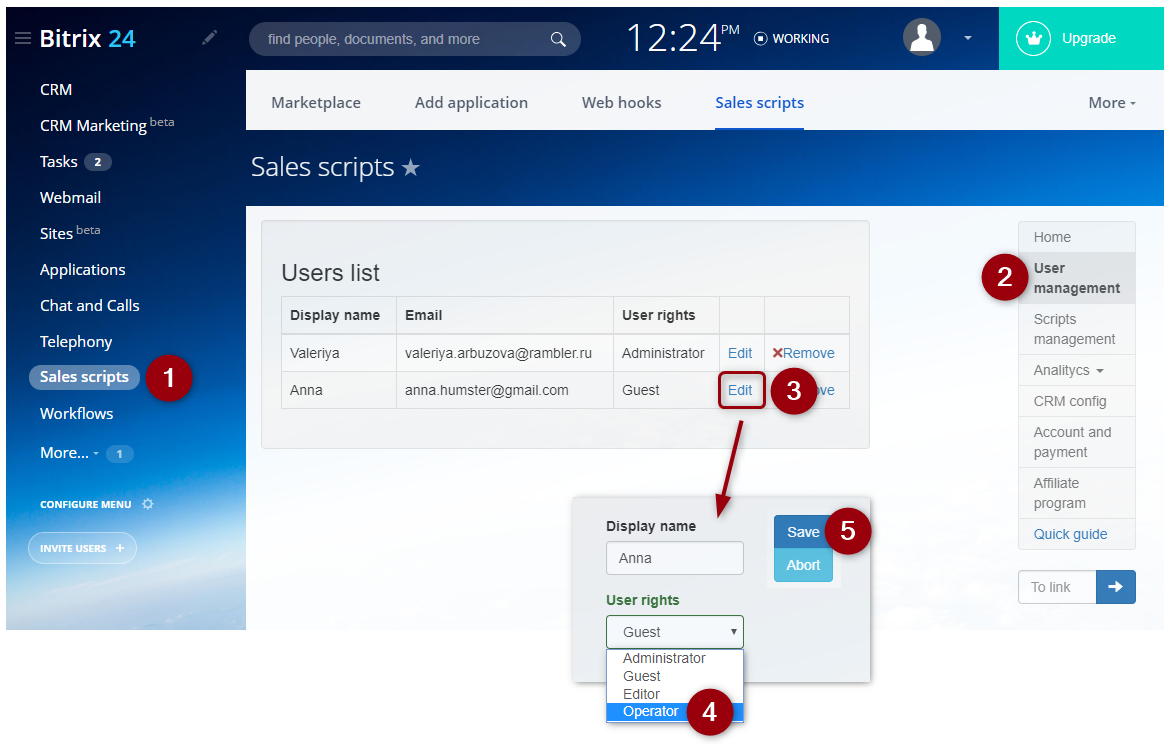
3. Prepare Sales Script
Sales script is a scenario of conversation between an operator and a customer.
An effective script helps the operator to answer the arising questions and dispel doubts of the customer.
3.1. Create Sales Script
At first, create an "empty" script, then put information that will make the operator's work as efficient as possible into the created script.

3.2. Fill in Sales Script
In CallHelper, sales script has a tree form. Each node of the tree contains instruction for an operator in case of the customer's questions or objections.
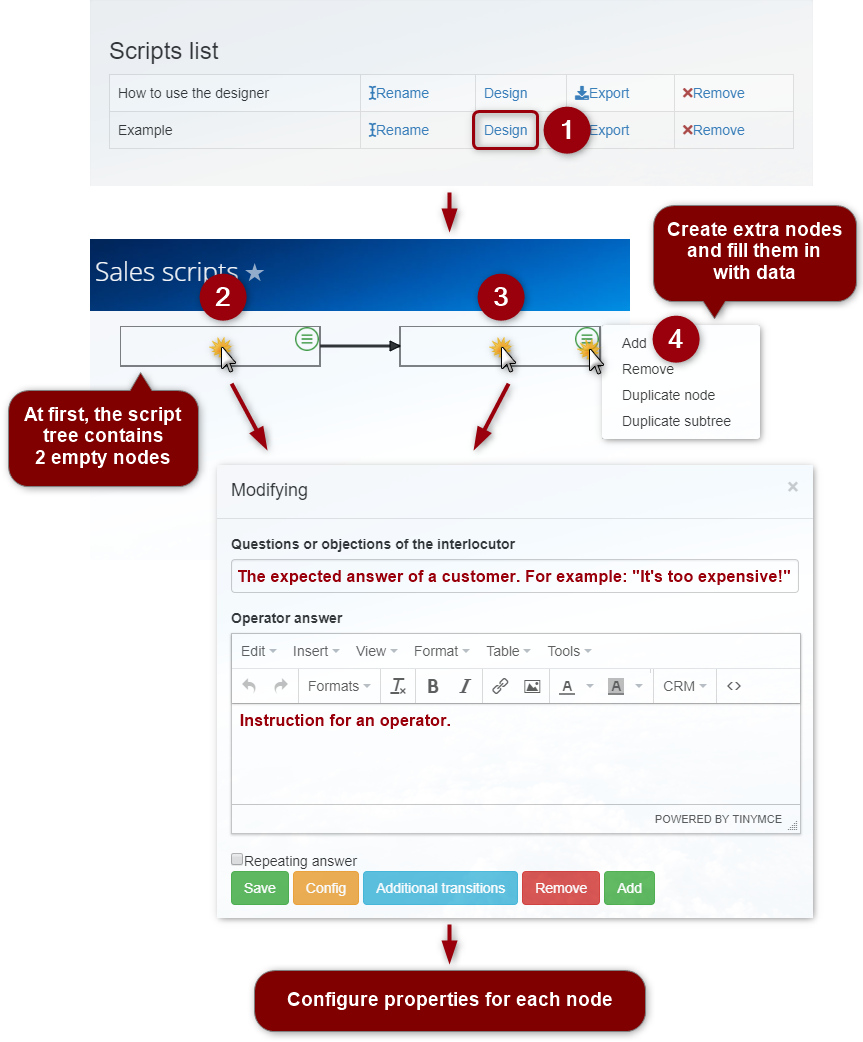
3.3. Configure Node Properties
Text Formatting
Formatting tools of the node allow highlighting the text and adding images and links to external sources.
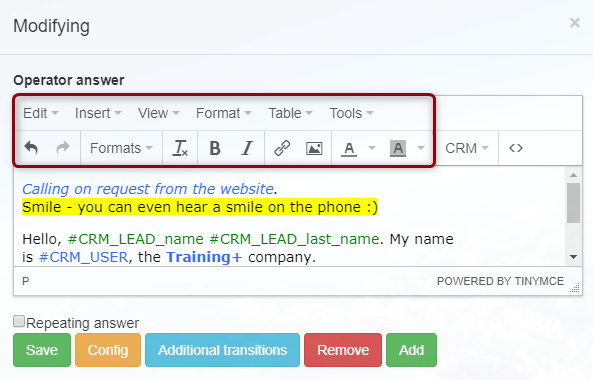
Quick Access to Node
A node that contains important information can be added to the "Go to" quick access menu, which is available from any node.
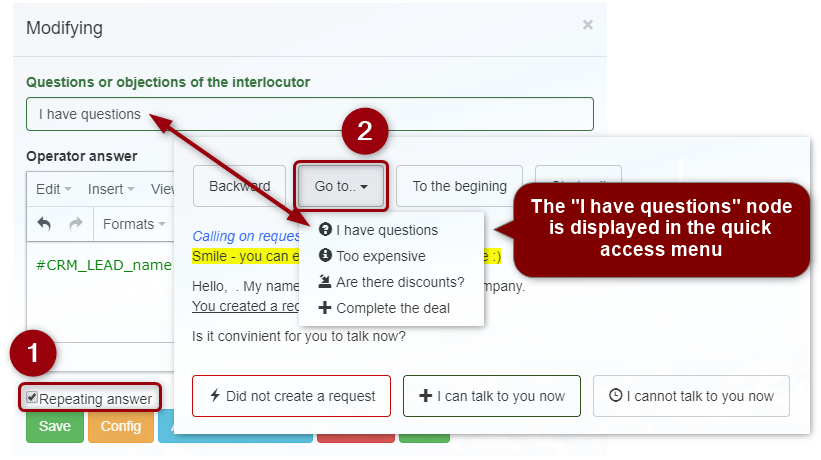
CRM Fields
Attention! To add CRM fields into the script text, you should first configure the list of fields available for adding.
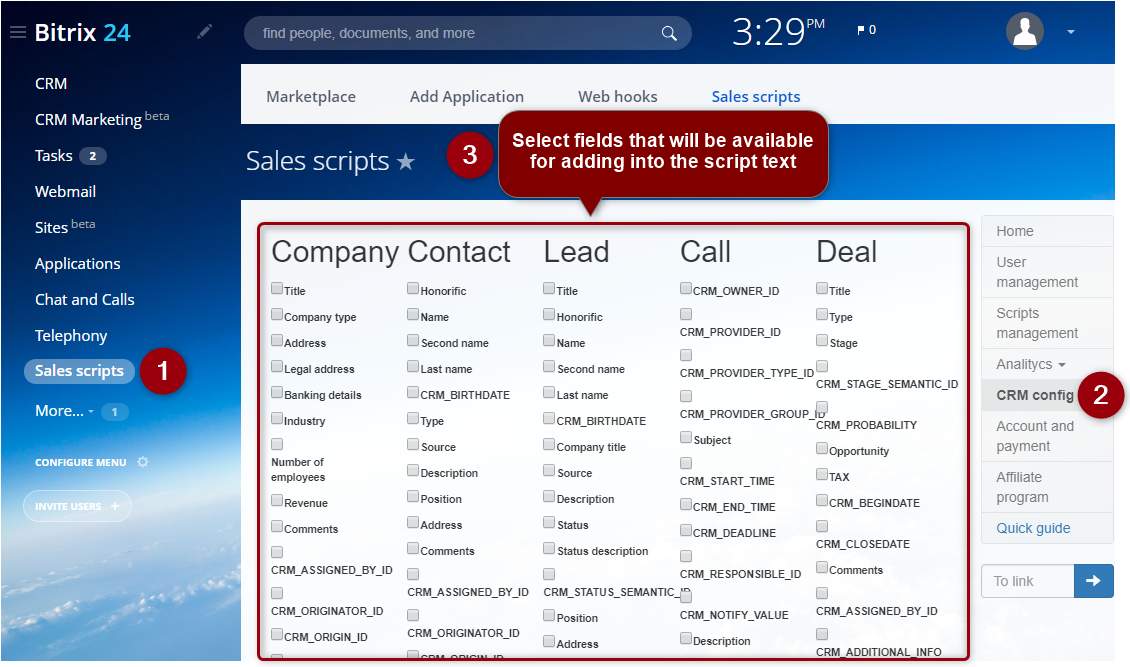
In edit mode, only tags of fields are displayed (for example, #CRM_LEAD_name).
In working mode, operators see details of a CRM object (contact, company, deal, etc.) instead of tags.
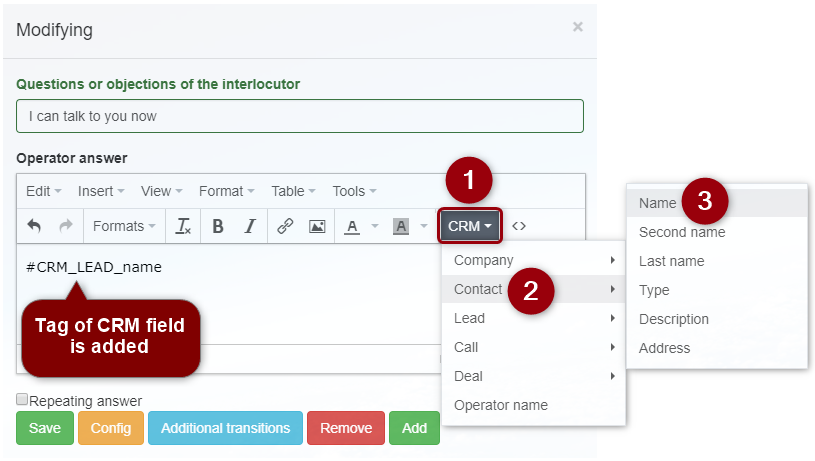
Frequent Answers
If the same answer can be used in different cases, there is no need to create copies. You can create just one node with this answer and add it to the required places via "additional transitions".
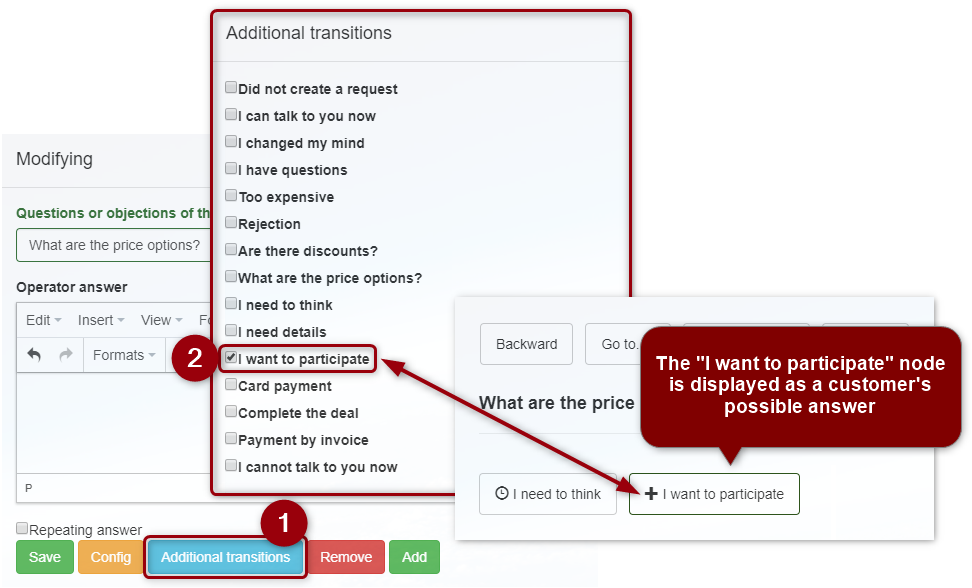
Color Scheme and Icons
You can select icons and color schemes for nodes and "additional transitions".

3.4. Manage Script Structure
Sometimes it is necessary to modify the created script tree: change logic of the conversation, add good examples of communication, and so on. With CallHelper, it is easy to manage the structure of the created tree: move nodes or the whole branches by dragging them to the required places.
Using different icons and color schemes of nodes and "additional transitions", you will not get confused when changing logic of the most complex conversation.

3.5. View Script in Operator's Interface
The created scripts are available from the Sales scripts section in the left menu and from any CRM object that is opened. After opening the required script, an operator follows instruction on the screen. Upon receiving the answer, question or objection of the customer, the operator selects the appropriate node with further instruction.
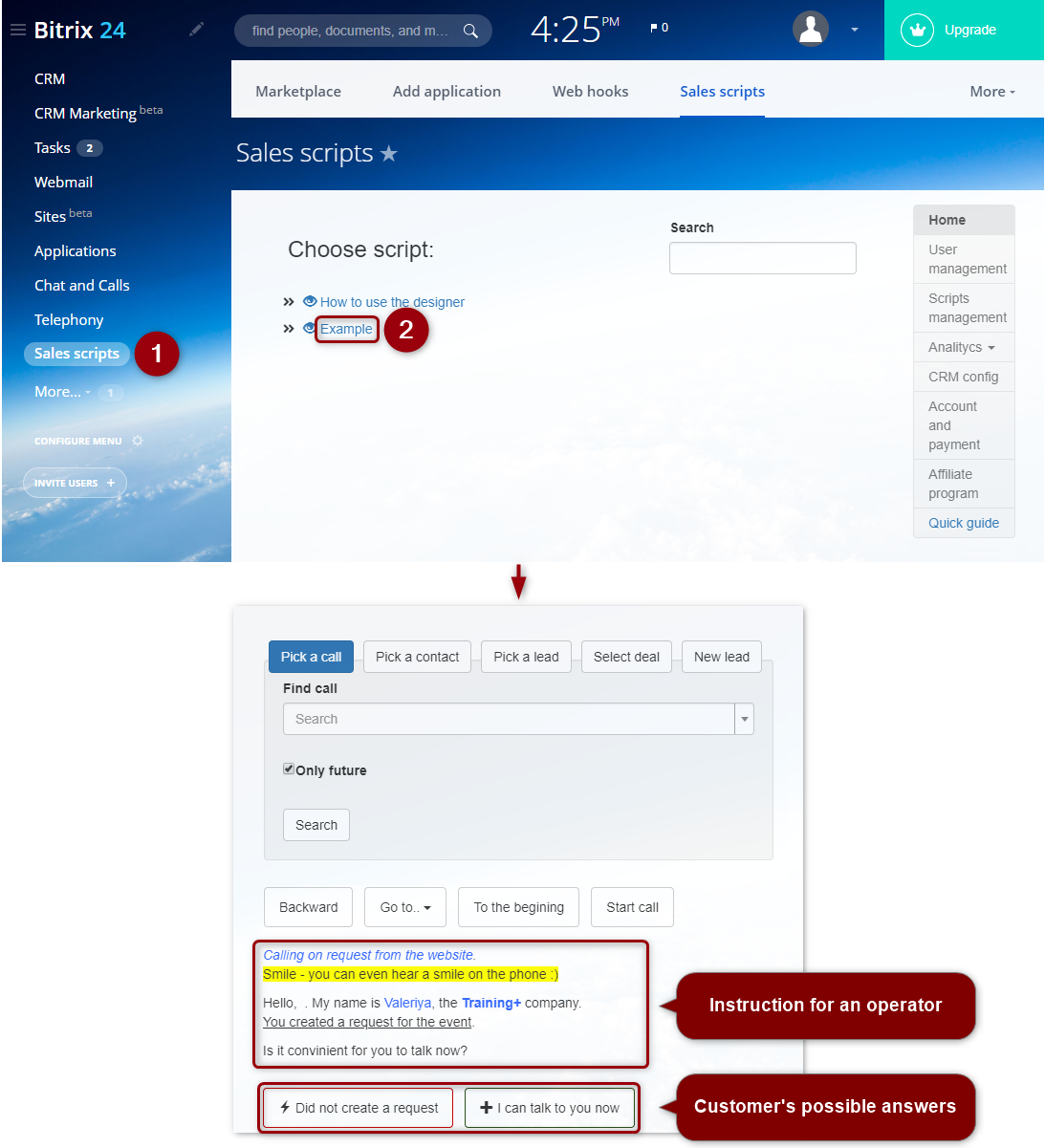
4. Conversation with Customer
4.1. Process Outgoing Call
When you work with an outgoing call in Bitrix24 using the CallHelper application, you get the following features:
- An operator follows the prepared text when talking to a customer.
- CRM data are displayed in the script text.
- During a call, the operator modifies data of a contact, a company, a deal, or a lead directly in the script interface. Changes are saved in Bitrix24 CRM immediately.
- At the end of the call, the operator describes call results and adds the call status (for example, "redial").
- When working with call lists, CallHelper automatically uploads data of the next selected contact after the current conversation is over.
- The manager plans further work with the contact according to its status and call results.
- The manager studies call statistics and exports it to Excel for further analysis.
4.1.1. Call from CRM Object
Using Built-in Telephony
When you call a customer using a built-in telephony of Bitrix24, the CallHelper application provides an operator with a list of scripts and uploads data from CRM directly in a call window.
Note: due to limitation of Bitrix24 API functionality in a call window, deal data are temporarily not displayed during a call. This functionality is planned to be improved by Bitrix24 specialists.
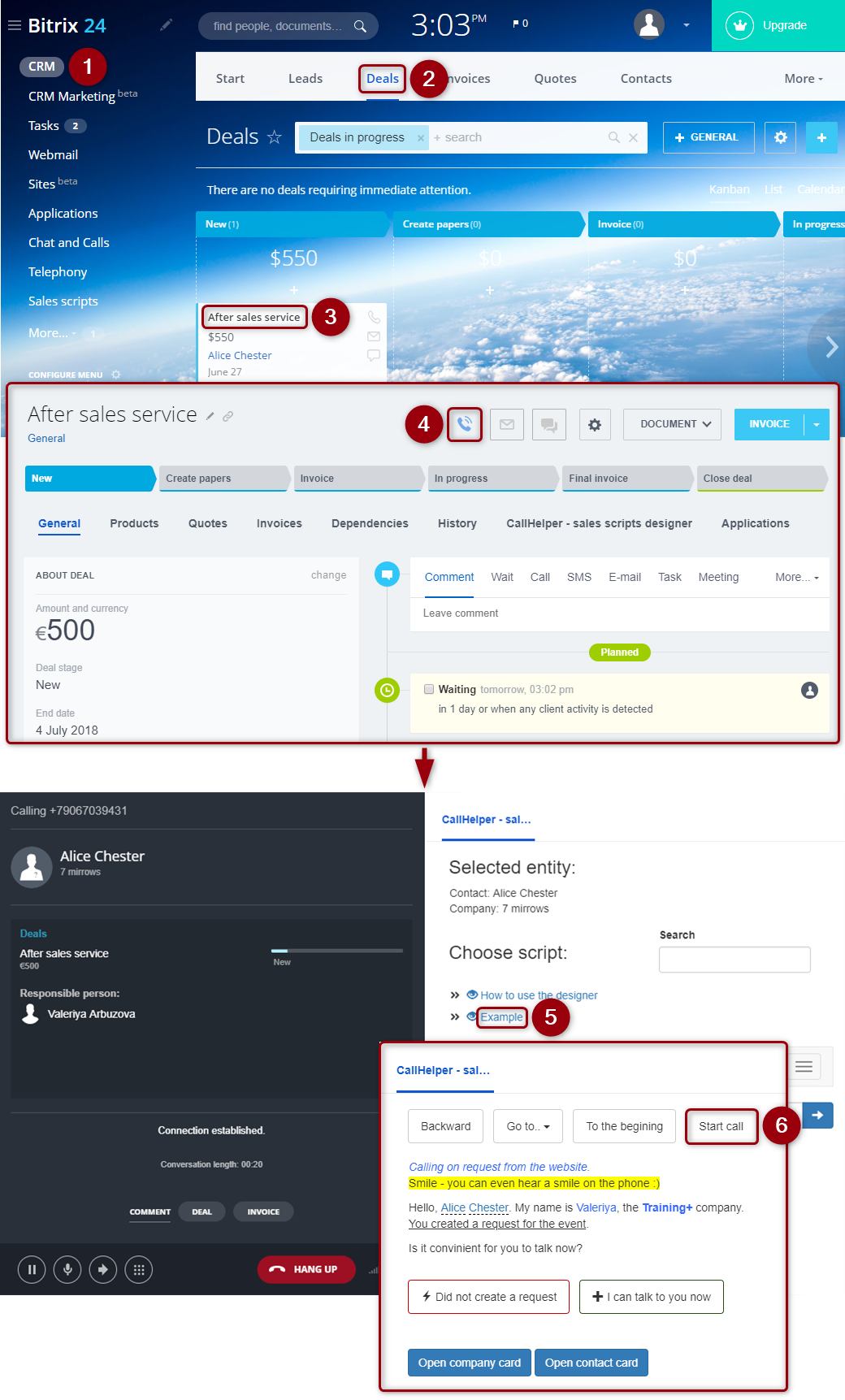
Using CallHelper
Even if you do not use a built-in telephony of Bitrix24, the CallHelper application will help an operator to organize convenient work with sales scripts and CRM data during calls.
Open CallHelper from any CRM object, select the required script, click Start call, and follow instructions on the screen. If you open CallHelper from a deal, the application will upload not only the deal itself, but also the associated contact and company.
Note: when you click the Start call button, CallHelper starts recording statistics (for more information on statistics, see section 6. Analytics), the phone number is not dialed.
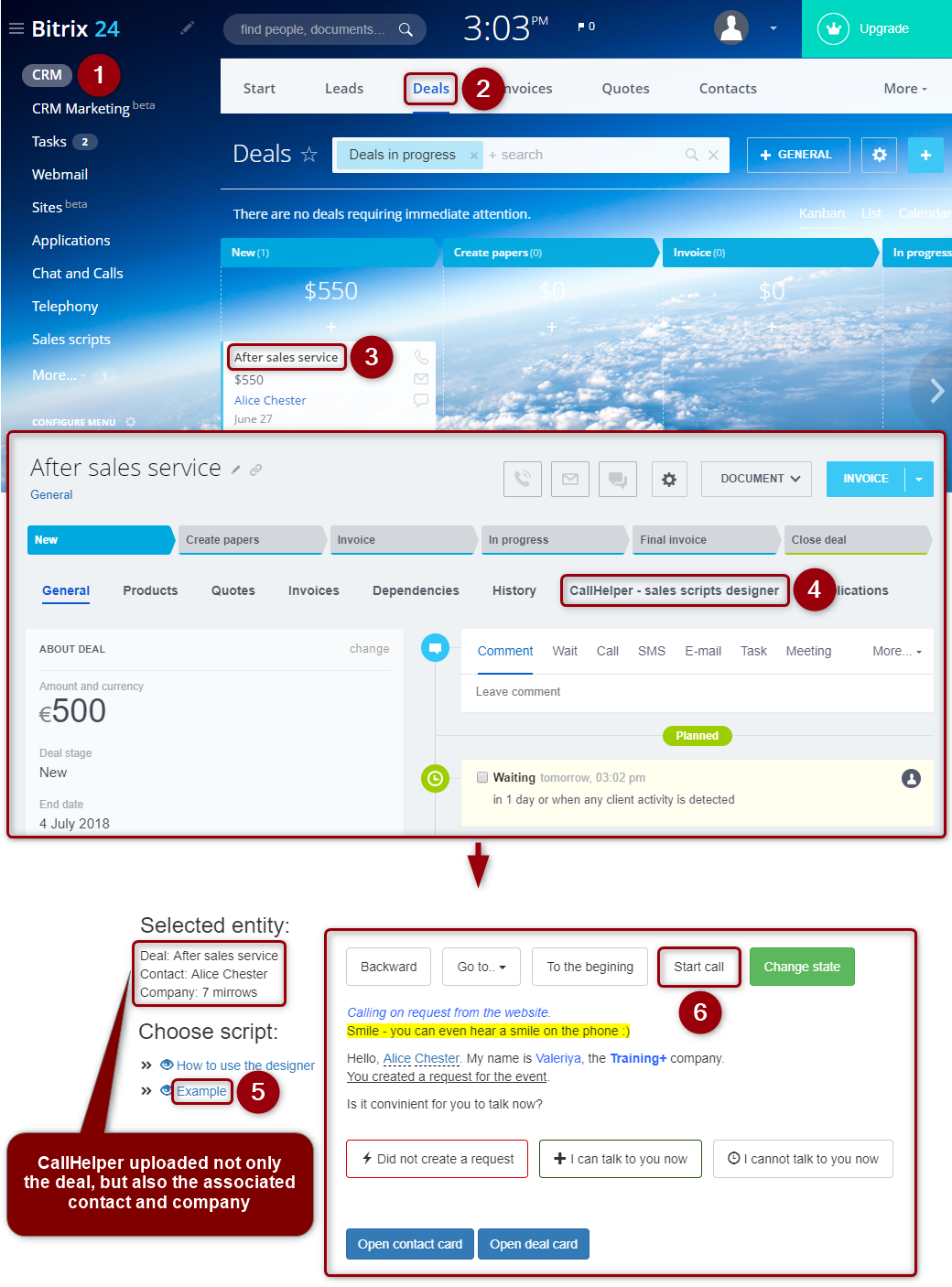
4.1.2. Call from Call List
When working with call lists, the CallHelper application automatically uploads data of the next selected contact after the current conversation is over, provides an operator with a list of scripts, and uploads data from CRM directly in a call window.
Note: due to limitation of Bitrix24 API functionality in a call window, deal data are temporarily not displayed during a call. This functionality is planned to be improved by Bitrix24 specialists.
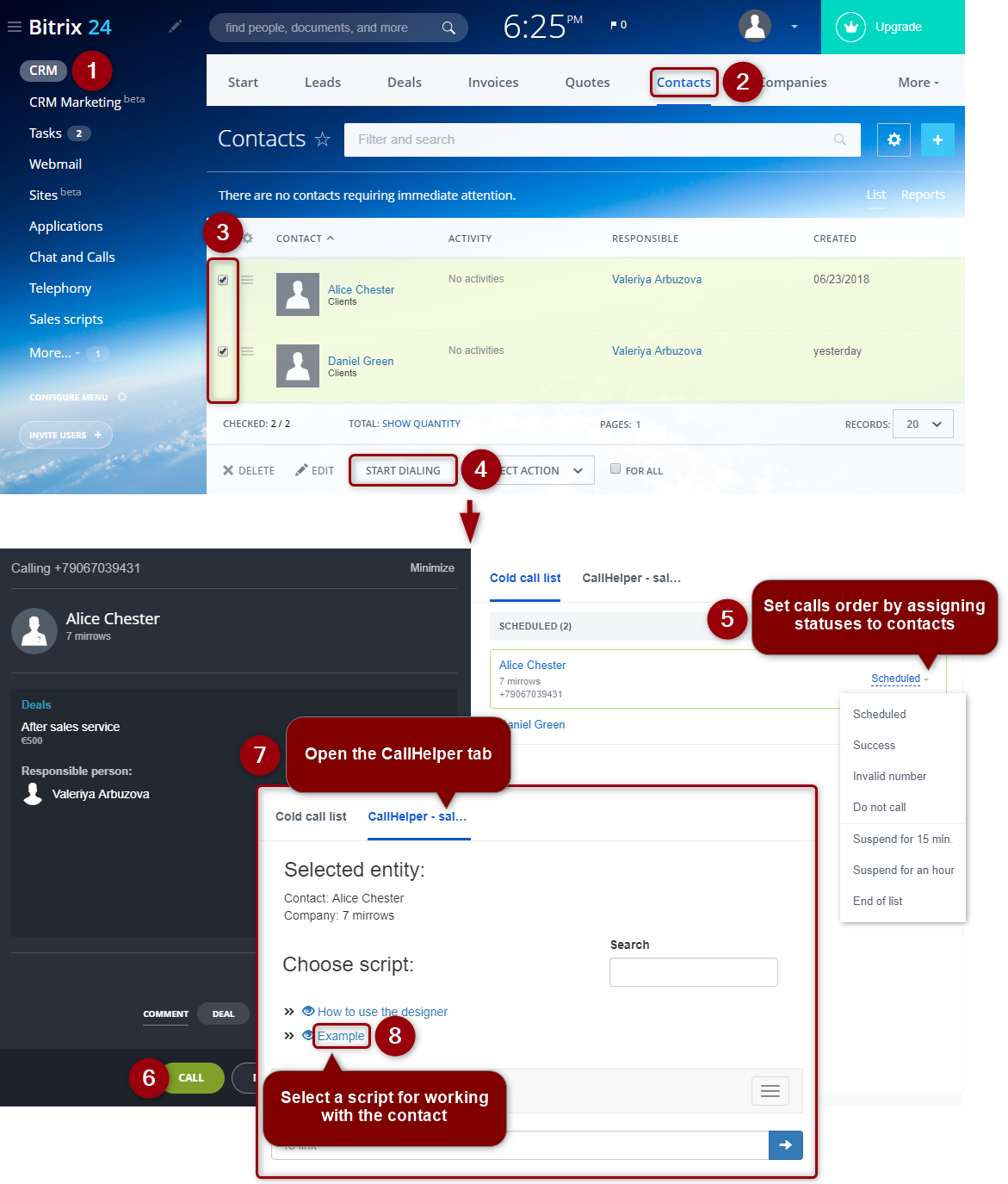
4.2. Process Incoming Call
When processing incoming and outgoing calls in Bitrix24, the CallHelper application works similarly. During an outgoing call, CallHelper uploads data of a CRM object from which the call was initiated; during an incoming call, CallHelper uploads data of a CRM object which was determined by Bitrix24 by the phone number.
If an incoming call is registered from an unknown phone number, an operator can create a lead during the call directly in a script interface.
We recommend that you set up automatic lead creation in Bitrix24 in case of an unknown incoming number. On such occasion, when receiving an incoming call, a new lead will be automatically created and uploaded. For more information on automatic lead creation, see this article.
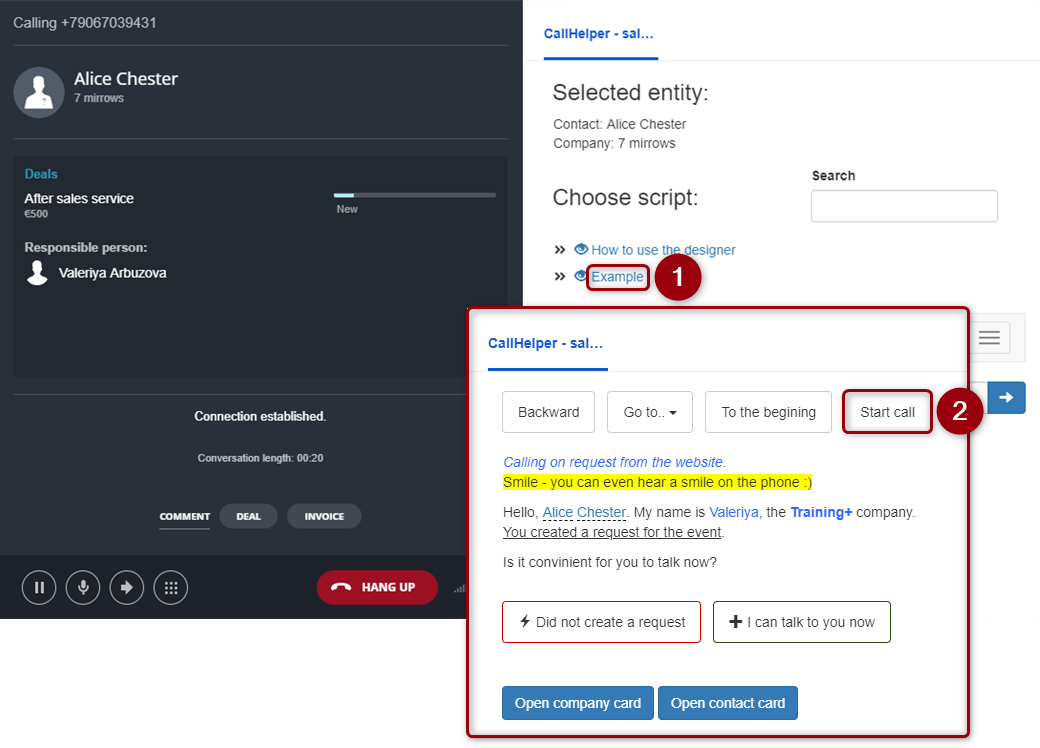
4.3. Modify CRM Data During Call
In the script interface, it is easy to quickly modify data of a contact, a company, a deal, and a lead. Changes are saved in Bitrix24 CRM immediately.
An operator can modify either a single field of a CRM object (for example, contact name) by clicking it in the script text or all fields of a CRM object by opening its card directly from the script.

4.4. Navigate the Script
During the conversation, an operator opens nodes with further instruction one after another. To do this, the operator can:
- select the required response of the customer;
- open the node with important information in the quick access menu;
- return to the previous/first node of the script.
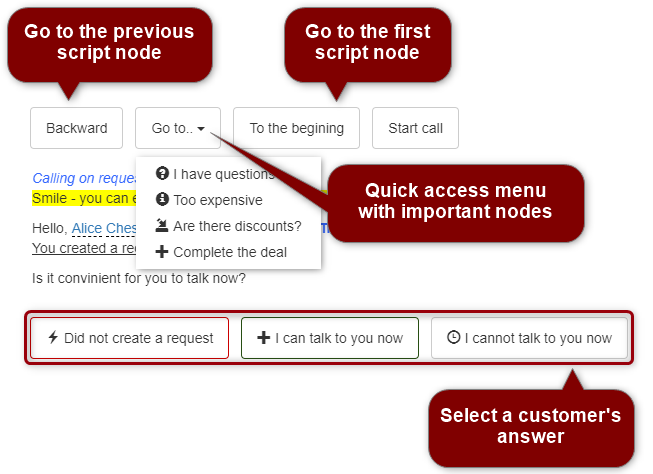
4.5. Complete the Conversation
After the conversation is over, the operator specifies the following information directly in the script:
- Call status (for example, "call answered")
- Comment
The manager uses these data to plan further work with the customer.
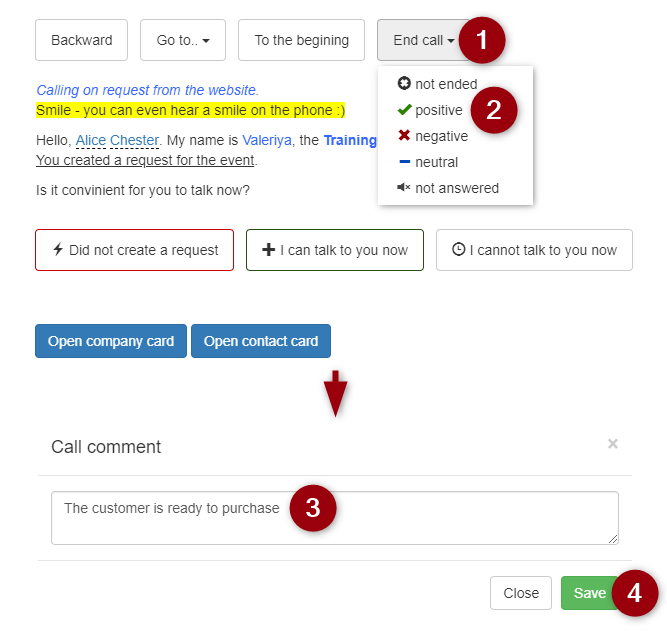
5. Training Mode
In training mode, an operator can view a script tree to learn the logic of the conversation, as well as open each node to learn the texts. During training, an open node looks the same way as in the operator's working interface.

6. Analytics
Various statistics options allow the manager to analyze the efficiency of sales scripts and operators' work without spending time listening to the records of calls.
6.1. Call Statistics – Table
The table with call statistics displays:
- Call start date and time
- Call duration
- Script that was used
- Operator's name
- Link to the deal, contact, and company
- Result of the conversation
- Number of transitions within the script tree
- Operator's comment
- Link to view the conversation steps in the script tree
In this table, you can sort columns, add filters, and export results for further analysis.
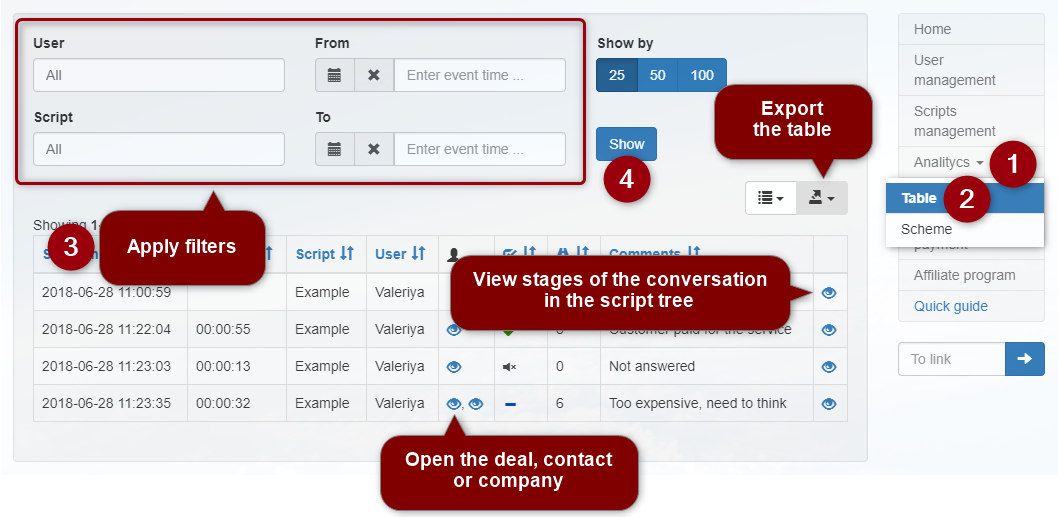
6.2. Call Statistics – Scheme
The call statistics scheme displays the number of operator's transitions within the script tree and the results of conversation in each node.
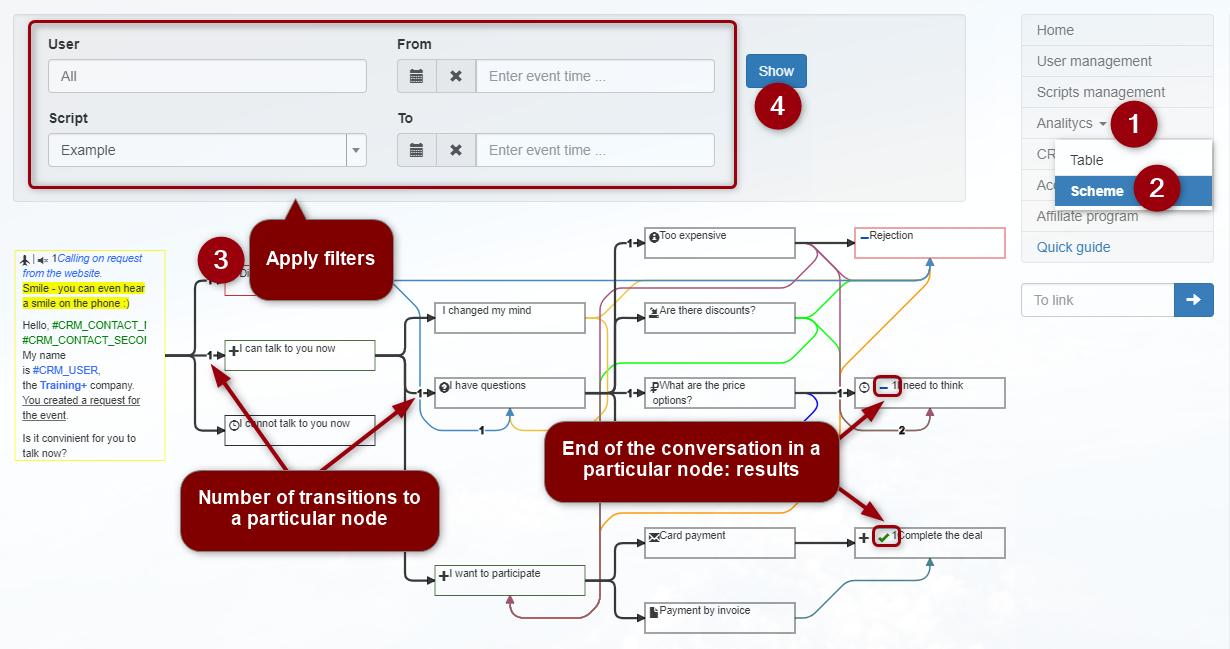
7. Questions?
If you still have questions after reading this manual, please contact out support team callhelp@kit-media.com or use the form on our website. We are glad to help you!
You can also try CallHelper as a standalone web application, an application for amoCRM, Salesforce, and SugarCRM! Read more about different product options on our website.